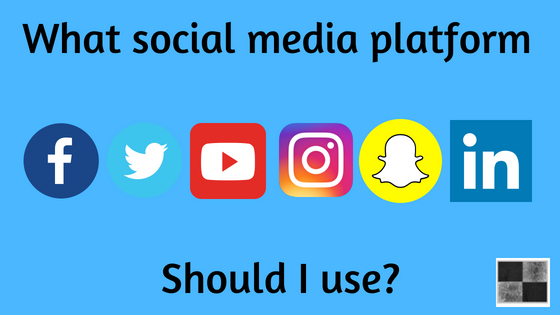
For many people, social media has become an everyday part of our lives. Because of the number of users, it’s hard to ignore social media when creating a public relation/marketing plan. You know your customers are accessing social media but what social platform should you use? Facebook? Instagram? YouTube?
The type of business that you have may help guide you to the right platform. For example, if you’re an accounting firm, Instagram may not be the best choice for you. However, the business type is not going to be the deciding factor.
Your audience is going to be the most critical piece of determining which platform or platforms you should be on. If your audience is on Snapchat, you should be on Snapchat. If they are on Twitter, you should be on Twitter. You get the idea.
As I said in the last article, social media should be part of a bigger plan that helps you meet your business goals. Without talking to you about your business and your goals, I can’t tell you where you should be. Even then, we would need to do some research to discover where your audience is.
This article is going to give you some high-level information about some of the most popular social media platforms. Understanding the different social media platforms is a big step in understanding where your audience might be and in turn which platform your business should be on. Over the next three weeks, we are going to look at some comparisons between the social platforms. This article will look at them at a high level. First off is the biggest platform. Facebook.
Is there anybody who hasn’t heard of Facebook? Even if you aren’t on Facebook, it’s hard to ignore. It has been all over the news lately. Facebook is the 800-pound gorilla in the room. Being the biggest social media platform with over 2.2* billion users worldwide it would be foolish to ignore them.
Facebook allows you to create a business page to promote your business. You can create a group around interests related to your business. You can share links, pictures, and video. You can also stream video live.
With Facebook’s reach and features, it’s is no wonder that it is the biggest platform. If you are going to pick only one platform to be on, this is the one.
Twitter may not have the most users at 330* million but it’s the place to be for breaking information. The President himself is a frequent user. Many other politicians, news services, and companies use Twitter to take the message directly to the people.
Twitter constrains its users to only 280 characters meaning you have to be to the point. You can also share links, pictures and video including streaming video. Twitter “chats” that are built around topics are also popular on the service.
YouTube
YouTube focuses on video and has over 1.5* billion users. It is also the 2nd largest search engine only behind Google, who happens to own it. YouTube is popular because of the sheer number of videos it has covering almost every topic one can think of. Like Facebook, it allows live streaming.
YouTube does some curation on its front page showing the popular and trending videos along with recommendations. While other social media platforms allow you to follow certain people or companies, YouTube offers subscriptions to YouTube channels.
They say a picture is worth a thousand words. That certainly wasn’t lost on Instagram, which is owned by Facebook. You can share pictures and up to ten minutes of video. Instagram stories allow users to share pictures and videos without it showing in the main feed. Because of the visual element, it has become one of the most popular platforms boasting 813* million users. If there is a strong visual component in your marketing that can be shared via pictures or video, Instagram would be a good choice.
Snapchat
The easiest way to describe Snapchat is as a messenger service…and a social platform making it unique amongst other platforms. Users can send a Snap, a picture, to other users via a private message. Snapchat Stories allows users to share on a timeline with everybody instead of via a message giving it the feel of a social platform.
While the other platforms allow their users to access via a computer or mobile device, Snapchat only allows its users to access its platform via a smartphone.
Content on Snapchat, which can be pictures or video, is ephemeral. This means it disappears after a short period of time instead of showing forever as on the other social platforms. This can make the experience feel more lifelike.
Snapchat has over 255* million users and is dominated by young adults and teenagers making it a great choice to engage this demographic.
LinkedIn is a social platform for professionals. The content, as you can imagine, is business related. You aren’t going to find cute cat videos on this site. It offers publishing and has been rolling out a video component.
You can set up a page that gives information on your business. The service also offers professional learning giving users the chance to pick up new skills or if your a thought leader, produce the videos. With a user network of 260* million, it is a great place to be your audience is professionals or business to business.
In Closing
That is high-level look at six of the most popular social media platforms. What’s your favorite of these six and why? Sound off in the comments and join me next week as I look closer at Facebook and Twitter.
*Figures according to Statista as of April 2018
- Is Your Marketing Connected? - March 6, 2025
- Stop Planning and Start Strategizing - October 24, 2024
- The Importance of Creating a Connection With Your Marketing - June 6, 2024
